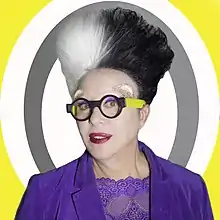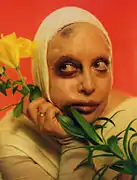Orlan
ORLAN (born Mireille Porte) is a French contemporary artist best known for her work with plastic surgery in the early to mid-1990s. ORLAN is known as a pioneer of carnal art, a form of self-portraiture that utilizes body modification to distort one's appearance. She adopted the pseudonym "ORLAN" in 1971. She lives and works in Paris.
ORLAN | |
|---|---|
 | |
| Born | Mireille Porte May 30, 1947 |
| Website | www |
She practices painting, sculpture, photography and video, and produces plastic works, installations and performances. She also uses digital media, surgery, medecine, robotics, AI and biotechnologies.
Biography
Early works
ORLAN's career as a performance artist began in 1964, when she performed Marches au ralenti (Slow motion walks) in her hometown of Saint-Étienne. During these performances, she would walk as slowly as possible between two central parts of the city.
In 1965, ORLAN produced MesuRages, in which she used her own body as a measuring instrument. With her "ORLAN-body" as the unit of measurement, she evaluated how many people could fit within a given architectural space. This was the first time she utilized her trousseau in a performance piece. ORLAN repurposed her trousseau in several later projects.
Between 1964 and 1966, ORLAN produced Vintages, a series of black and white photographic works. She destroyed the original negatives of these pieces, and today only one copy of each photograph remains. In this series, she posed naked in various yoga-like positions. One of the most famous pictures of this series is ORLAN accouche d'elle m'aime.
Between 1967 and 1975, ORLAN produced a body of work entitled Tableaux Vivants. She based these on the works of Baroque artists such as El Greco and Gericault. She used prison inmates as models, wore exaggerated faux-Baroque costumes, and drew inspiration from Caravaggesque stereotypes. In 1971, ORLAN "baptized herself" Sainte-ORLAN, adorning herself with billowing black vinyl and white leatherette. Color photographs of Saint ORLAN were later incorporated into photo-collages, videos, and films tracing a fictive hagiography.
During the 1977 FIAC International Contemporary Art Fair in Paris, ORLAN executed the controversial performance piece The Artist's Kiss (Le baiser de l'artiste). Outside the Grand Palais in Paris, a life-size photo of her torso was turned into a slot machine. Spectators could see the coin they inserted into the torso descend down into a groin before being awarded a kiss from the artist.
In 1972, ORLAN created Documentary Study: The Head of Medusa, in which she displayed her sexual organs during menstruation under a magnifying glass. The installation was organized in Aachen, Germany on occasion of an International Symposium of Performance Art at the Ludwig Forum for International art. The piece's title was derived from the statement by Sigmund Freud that "at the sight of the vulva, even the devil runs away," which he articulated in his short, posthumously-published essay entitled "Medusa's Head."
In 1978, ORLAN founded the International Symposium of Performance in Lyon where she also explored the use of new technologies in the arts. In 1982, with Frederic Develay, she created the first online contemporary art creation magazine, Art-Acces-Revue, on Minitel. This magazine invites international artists working in situ and/or with conceptual issues to create original works specially designed on Minitel (Bernar Venet, Vera Molnar, Ben, Francois Morellet, Daniel Buren...). This database was represented in the exhibition Les immateriaux by Jean-Francois Lyotard.
At the end of the 1990's, Self-hybridations, the artist uses through digital photography and computer graphics retouching software, hybridizes her face of "Euro-Stephane" woman with extra-western canons of beauty (pre-Columbian, African, Amerindian, Chinese....).
ORLAN further expands the frontiers of contemporary art by using biotechnology to create “Harlequin’s Coat” in 2007, made from the artist's own cells and cells of human and animal origin in Perth, Australia in Symbiotico's laboratory.
Since 1998, ORLAN has been creating a digital photographic series titled "Self-Hybridizations," where her face merges with past facial representations (masks, sculptures, paintings) of non-western civilizations. So far, three have been completed: Pre-Columbian, Native American and African.
In 1999, ORLAN was appointed to teach at the École Nationale Supérieure d'Arts de Paris-Cergy, France.[1]
The Reincarnation of Saint-ORLAN
In 1990, ORLAN began the The Reincarnation of Sainte-ORLAN. It involves a series of plastic surgeries through which the artist transformed herself into elements from famous paintings and sculptures of women. As a part of her "Carnal Art" manifesto, these works were filmed and broadcast in institutions throughout the world, such as the Centre Georges Pompidou in Paris and the Sandra Gehring Gallery in New York.[2]
ORLAN's goal in these surgeries is to acquire the ideal of female beauty as depicted by male artists. When the surgeries are complete, she will have the chin of Botticelli's Venus, the nose of Jean-Léon Gérôme's Psyche, the lips of François Boucher's Europa, the eyes of Diana (as depicted in a 16th-century French School of Fontainebleau painting), and the forehead of Leonardo da Vinci's Mona Lisa. ORLAN picked these characters, "not for the canons of beauty they represent... but rather on account of the stories associated with them." ORLAN chose Diana, because she is inferior to the gods and men, but is leader of the goddesses and women; Mona Lisa, because of the standard of beauty, or anti-beauty, that she represents; Psyche, because of the fragility and vulnerability within her soul; Venus, for carnal beauty; and Europa, for her adventurous outlook on the future.[3]
ORLAN defines cosmetic surgery as "nomadic, mutant, shifting, differing." ORLAN has stated, "my work is a struggle against the innate, the inexorable, the programmed, Nature, DNA (which is our direct rival as far as artists of representation are concerned), and God!".[4] In an interview with Acne Paper, ORLAN stated:
I can observe my own body cut open, without suffering!... I see myself all the way down to my entrails; a new mirror stage... I can see to the heart of my lover; his splendid design has nothing to do with sickly sentimentalities... Darling, I love your spleen; I love your liver; I adore your pancreas, and the line of your femur excites me." (from Carnal Art manifesto) "Sainte ORLAN" came from a character that I created for "Le baiser de l'artiste" from a text called "Facing a society of mothers and merchants." The first line of this text was: "At the bottom of the cross were two women, Maria and Maria Magdalena." These are two inevitable stereotypes of women that are hard to avoid: the mother and the prostitute. In "Le baiser de l'artiste" there were two faces. One was Saint ORLAN, a cutout picture of me dressed as Madonna glued onto wood. One could buy a five francs church candle and I was sitting on the other side behind the mock-up of the vending machine. One could buy a French kiss from me for the same amount of money one could buy a candle. The idea was to play on the ambivalence of the woman figure and the desire of both men and women towards those biblical and social stereotypes. Being showcased in the Paris International Contemporary Art Fair.[5]
- Photographs of ORLAN
 Portrait by Fabrice Lévêque in 1990.
Portrait by Fabrice Lévêque in 1990. Portrait by Fabrice Lévêque in 1997.
Portrait by Fabrice Lévêque in 1997. Portrait by Fabrice Lévêque in 1997.
Portrait by Fabrice Lévêque in 1997. Portrait by Fabrice Lévêque in 1997. Polaroid instant film.
Portrait by Fabrice Lévêque in 1997. Polaroid instant film.
In the 2000s
In 2001, ORLAN orchestrated a series of filmic posters, "Le Plan du Film," with various artists and writers. She collaborated in 2008 with the SymbioticA laboratory in Australia, resulting in the bio-art installation "The Harlequin's Coat."Part of ORLAN's on-going work includes "Suture/Hybridize/Recycle," a generative and collaborative series of clothing made from ORLAN's wardrobe and focusing on suture: the deconstruction of past clothing reconstructed into new clothing that highlights the sutures.
In June 2013, she filed a complaint against Lady Gaga. For ORLAN, the American star, in the album Born This Way released in 2011 is inspired by the artist without quoting her. The beginning of the video clip of the homonymous song shows Lady Gaga with implants similar to those of ORLAN and the face of Lady Gaga beheaded recalls the work Woman with head created in 1996. Her lawyer is asking for a compensation of 31.7 million dollars. The hearing was set for July 7, 2016 at the Tribunal de la Grande Instance de Paris. A first verdict was announced against ORLAN but the artist decided to appeal. In May 2018, the Court of Appeal of Paris rejected ORLAN by confirming the absence of parasitic nature of the video clip.
It receives the Reputation on line Prize (Grand Prix de l'e-réputation) in 2013, organized by the art critic Alexia Guggemos, Plastic Arts category, which rewards the most popular personalities on the Internet alongside Phillipe Starck for design and Yann Arthus-Bertrand for photography.[6]
In 2018, ORLAN creates a robot in her own image, "ORLANoïde", equipped with collective and social artificial intelligence that speaks with her voice by reading texts from a text generator: presented at the Grand Palais, for the exhibition "Artists and Robots", the robot is also part of a performance entitled "Electronic and verbal striptease" and also benefits from a motion generator. It is a work in Progress, currently the developers of the Art and science gallery in Dublin are developing other capacities.[7]
In 2019, she is honored with the special prize of Woman of the Year, awarded by the Prince of Monte Carlo. ORLAN is also appointed Professor Emeritus of the Accademia di Belle Arti di Roma.[8]
During the confinement, in 2020, ORLAN wrote her autobiography published by Gallimard.
She is represented in France by the Ceysson & Bénétière Gallery.
Notes
- "ORLAN Biography – ORLAN on artnet". www.artnet.com. Retrieved 2020-12-15.
- Orlan 'Manifesto of Carnal Art/L'Art Charnel and Refiguration/Self-Hybridation series and other works' vol.12 July 2003 n.paradoxa: international feminist art journal pp.44-48
- Bernard Blistène; Christine Buci-Glucksmann; Regis Durand; et al. (2004). Orlan : [carnal art]. Translated by Deke Dusinberre (English lang. ed.). Paris: Flammarion. ISBN 9782080304315.
- Jeffreys, Sheila (2005). Beauty and misogyny : harmful cultural practices in the west (Reprinted. ed.). London: Routledge. ISBN 9780415351836.
- Mitrofanov, Oleg (2010). "Devotion – Orlan (Paris) – Artist". Acne Paper (9): 34.
- https://www.huffingtonpost.fr/alexia-guggemos/ereputation-orlan_b_4208992.html
- https://www.vogue.fr/fashion-culture/fashion-exhibitions/diaporama/artists-and-robots-the-new-immersive-exhibition-to-see-at-the-grand-palais/50405
- https://ashadedviewonfashion.com/2019/05/05/orlan-is-elected-woman-of-the-year-for-the-prix-special-of-monaco/
References
- Smith, K. (2007). Abject Bodies Beckett, Orlan, Stelarc and the politics of contemporary performance. Performance Research, 12(1), 66–76.
- Zerihan, R. (2012). ORLAN: A Hybrid Body of Artworks. Contemporary Theatre Review, 22(3), 426–428.
- Ayers, R. (1999). Serene and Happy and Distant: An Interview with Orlan. Body & Society, 5(2/3), 171.
- Knafo, D. (2009). Castration and Medusa: Orlan’s Art on the Cutting Edge. Studies in Gender & Sexuality, 10(3), 142–158.
- Lovelace, C. (1995). Orlan: Offensive Acts. Performing Arts Journal, 17(1), 13-25. doi:10.2307/3245692
- Rose, B. (1993). Is it art? Orlan and the transgressive act. Art in America, 81(2), 82.
- Sayej, N. (2020, March 26). ORLAN: “I walked a long way for women.” The Guardian.
External links
- Official website
- Retrospective Exhibition from 05/25/07 to 09/16/07 at the Musée d'art moderne de Saint-Etienne
- Pompidou Centre, exhibition: elles@centrepompidou 2010.
- Video: interview with ORLAN, registration of a MesuRage, and short overview of her work at M HKA, Antwerp
